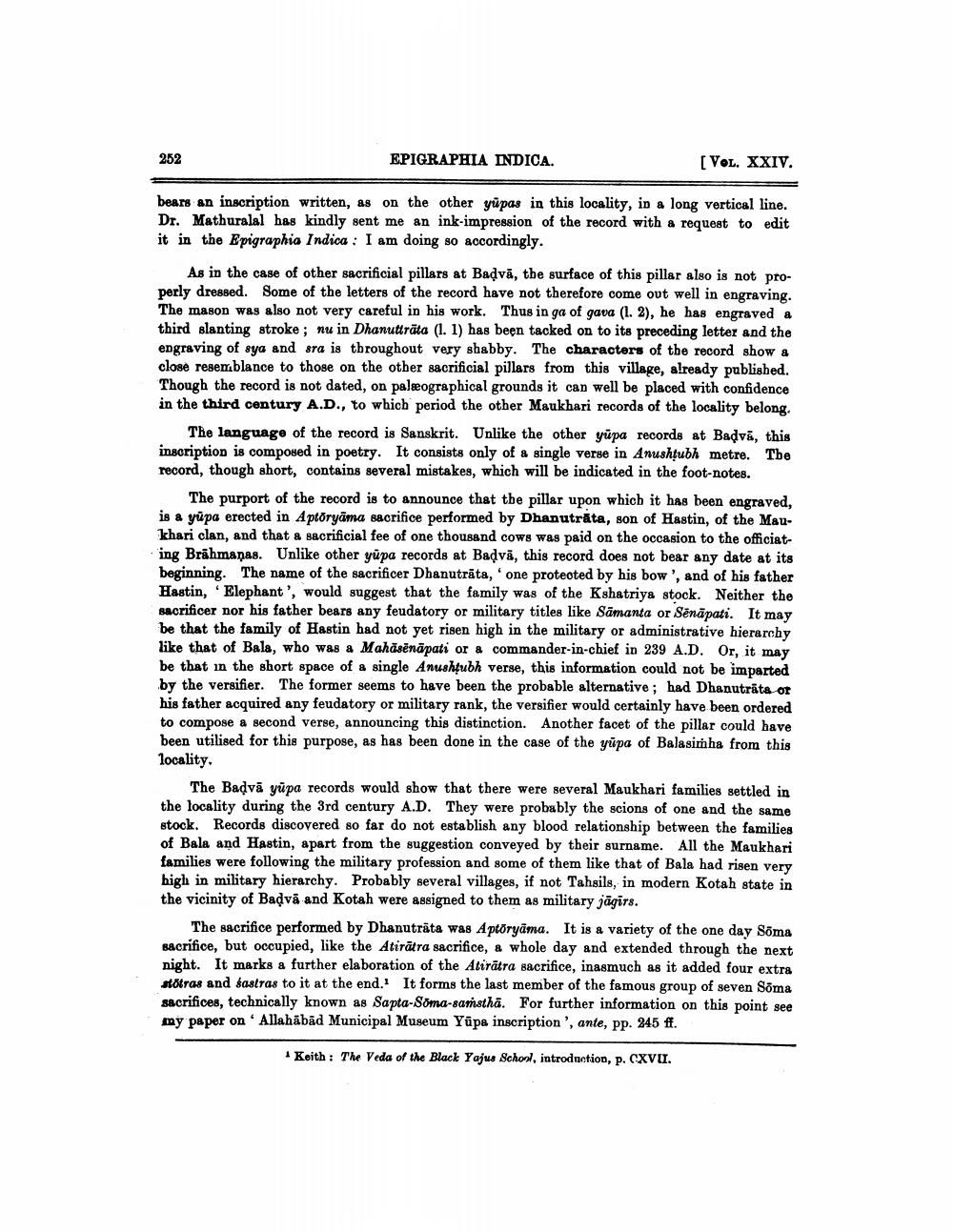________________
252
EPIGRAPHIA INDICA.
[Vol. XXIV.
bears an inscription written, as on the other yūpas in this locality, in a long vertical line. Dr. Mathuralal has kindly sent me an ink-impression of the record with a request to edit it in the Epigraphia Indica : I am doing so accordingly.
As in the case of other sacrificial pillars at Badvā, the surface of this pillar also is not properly dressed. Some of the letters of the record have not therefore come out well in engraving. The mason was also not very careful in his work. Thus in ga of gava (1.2), he has engraved a third slanting stroke; nu in Dhanutrāta (1.1) has been tacked on to its preceding letter and the engraving of sya and sra is throughout very shabby. The characters of the record show a close resemblance to those on the other sacrificial pillars from this village, already published. Though the record is not dated, on palæographical grounds it can well be placed with confidence in the third century A.D., to which period the other Maukhari records of the locality belong.
The language of the record is Sanskrit. Unlike the other yüpa records at Badvā, this inscription is composed in poetry. It consists only of a single verse in Anushtubh metre. The record, though short, contains several mistakes, which will be indicated in the foot-notes.
The purport of the record is to announce that the pillar upon which it has been engraved. is a yüpa erected in Aptoryäma sacrifice performed by Dhanutráta, son of Hastin, of the Maukhari clan, and that a sacrificial fee of one thousand cows was paid on the occasion to the officiating Brāhmanas. Unlike other yüpa records at Badvā, this record does not bear any date at its beginning. The name of the sacrificer Dhanutrāta, one proteoted by his bow', and of his father Hastin, Elephant', would suggest that the family was of the Kshatriya stock. Neither the sacrificer nor his father bears any feudatory or military titles like Samanta or Senāpati. It may be that the family of Hastin had not yet risen high in the military or administrative hierarchy like that of Bala, who was a Mahāsënāpati or a commander-in-chief in 239 A.D. Or, it may be that in the short space of a single Anushțubh verse, this information could not be imparted by the versifier. The former seems to have been the probable alternative; had Dhanuträts of his father acquired any feudatory or military rank, the versifier would certainly have been ordered to compose a second verse, announcing this distinction. Another facet of the pillar could have been utilised for this purpose, as has been done in the case of the yüpa of Balasimha from this locality,
The Badvā yüpa records would show that there were several Maukhari families settled in the locality during the 3rd century A.D. They were probably the scions of one and the same stock. Records discovered so far do not establish any blood relationship between the families of Bala and Hastin, apart from the suggestion conveyed by their surname. All the Maukhari families were following the military profession and some of them like that of Bala had risen very high in military hierarchy. Probably several villages, if not Tahsils, in modern Kotah state in the vicinity of Badva and Kotah were assigned to them as military jāgirs.
The sacrifice performed by Dhanutrāta was Aptöryāma. It is a variety of the one day Sõma sacrifice, but occupied, like the Atitātra sacrifice, a whole day and extended through the next night. It marks a further elaboration of the Atiratra sacrifice, inasmuch as it added four extra stotras and sastras to it at the end. It forms the last member of the famous group of seven Soma sacrifices, technically known as Sapta-Soma-samstha. For further information on this point see my paper on Allahābād Municipal Museum Yüpa inscription', ante, pp. 245 ff.
Keith: The Veda of the Black Yajus School, introduction, p. CXVII.




